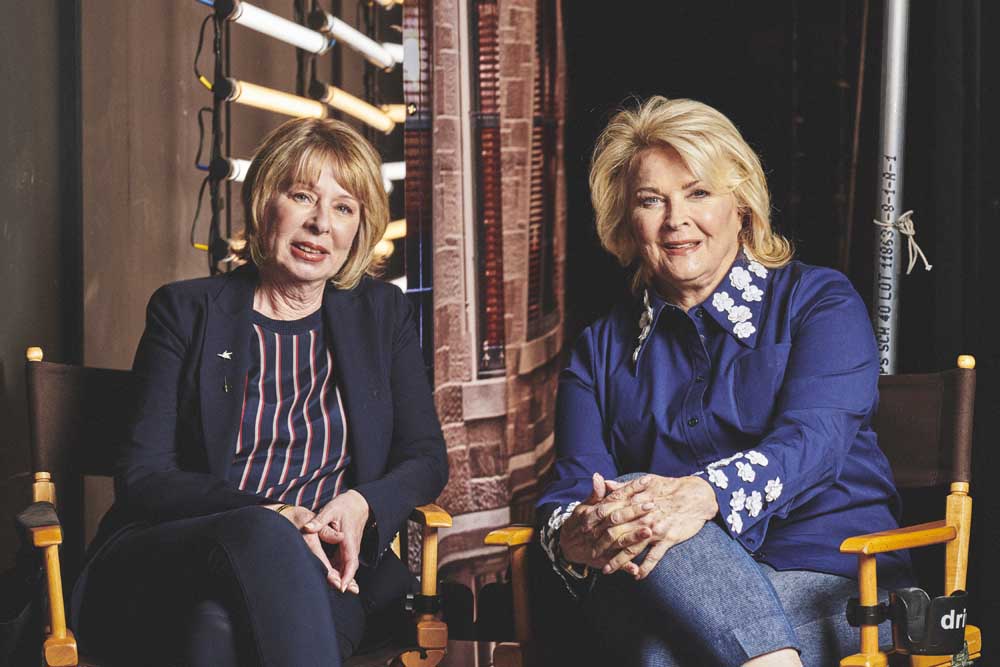‘Murphy Brown’ returns, not for the better
Published 12:00 am Sunday, September 30, 2018

- The “Murphy Brown” star Candice Bergen, right, with series creator Diane English, are bringing the sitcom back 20 years later.(Bryan Derballa/The New York Times)
When Murphy Brown (Candice Bergen) walks back into Phil’s Bar (now run by Tyne Daly as Phil’s sister, Phyllis), the studio audience applauds. Why wouldn’t they? The original “Murphy Brown” was a cultural milestone, and Bergen’s acid performance as a brilliant, abrasive TV journalist was a classic of the form.
In another episode, Murphy’s old colleague Jim Dial (Charles Kimbrough) tells her not to give in to pressure to interview the white nationalist blowhard Ed Shannon (David Costabile, wearing multiple shirts lest you miss the Steve Bannon rhyme). “You don’t have to give equal time to someone who claims Tom Hanks is running a shadow government,” Jim says. Again, the audience applauds.
Later, Murphy runs into Shannon at the bar, and immolates him in an argument, telling him that he’s going to end up “a sad, sad, sad, sad dinosaur who went extinct.”
The audience applauds, and applauds again.
The revival is feisty and eager to meet the Trumpian moment. But it’s become the kind of sitcom that prefers applause to laughs.
You can’t say “Murphy Brown” lacks timing. The clash of exasperated women and condescending men was the fuel for many a past episode, not to mention the character’s meta-feud with Vice President Dan Quayle, who attacked the show in 1992 when her character became an unwed mother.
Now locker-room talk, resistance and persistence are daily news. The day the show returned, Christine Blasey Ford was in Congress to raise charges of sexual assault against the Supreme Court nominee Brett M. Kavanaugh, recalling the Anita Hill and Clarence Thomas hearings that the original series satirized in the episode “Send in the Clowns.” The culture has all but sent up a Murphy-shaped bat-signal.
The extended return episode begins the night of the 2016 election, which motivates Murphy to come out of retirement and host a cable-news morning show. She gets the band back together from her old show, “FYI”: Frank Fontana (Joe Regalbuto), the investigative reporter; Corky Sherwood (Faith Ford, her timing sharp as ever), a former ingénue now facing age discrimination herself; and the perennially frazzled Miles Silverberg (Grant Shaud).
Politics aren’t all that’s changed since the Bush-Clinton years. TV is different. The first “Murphy Brown” had the late 20th century concern that TV news was mushing into bland infotainment. Now it’s a nonstop, splenetic opinion and anger machine. Serious news is attacked as “fake” from the Oval Office. And Murphy is pitted against her own son, Avery (Jake McDorman), starting a show in the same time slot on the conservative Wolf Network (filling in for another canid).
There are callbacks and fan service — the running joke about Murphy’s chain of unreliable assistants returns. But the first episode also leans on “Murphy gets used to technology” jokes, as if she had been not just retired but frozen in a block of ice. Her antique flip phone amazes Pat Patel (Nik Dodani), the social-media guy.
Twitter does inspire one hearty laugh, a savage echo of Roseanne Barr’s brief comeback: “Think before you tweet,” Avery warns Murphy. “Shows have been canceled for less.”
Murphy masters the new medium quickly, winning a flame war with @realdonaldtrump. She masters morning TV and the ratings fight and run-ins with the administration and with her own network’s brass. “Murphy Brown” wants to make clear that Murphy’s still got it. But the show itself is kludgy, combining dated sitcom rhythms with sermonizing.
The original Murphy was heroic not because she was never wrong, but because she was talented, unapologetic and flawed. She entered the series’ pilot on the rebound from rehab, and her category-5 arrival was a model of economical character establishment.
The show was plenty topical — the old episodes (a few of them newly available on CBS All Access) are full of references with the shelf life of raw milk. But its biggest political statement was Murphy herself and her ability to be as much of a swaggering, difficult force as any man in her job.
Maybe the best aspect of the new version is Murphy’s relationship with Avery, who’s Wolf News’ “token liberal” and Murphy’s new housemate. It’s an interesting choice (even if Wolf’s real-life analogue isn’t so eager to give morning shows to nonconservatives). Their differences aren’t “Crossfire”-style left-right showdowns but gently needling exchanges about confrontation vs. incrementalism.
It’s the one area where it feels like this “Murphy Brown” is trying something new, imagining what the Murphy of 2018 would be like rather than offering the wish-fulfillment of teleporting a sitcom legend to the present to bust some chops.
Not that we can’t use a little of that. There is a definite kick to hearing, on CBS’ air, a zinger about the sexual-harassment downfall of its own host, Charlie Rose. But somewhere in translation, “Murphy Brown” has become the kind of sitcom you laugh at, not because you can’t help it, but because you feel you should.







